Previously: 112 Ocean Avenue, Amityville.
The island has been there for centuries. Lush and green, it appears almost jungle-like from afar; it’s only when you get closer — it’s reachable by boat, if you know who to ask — that it becomes apparent that it’s no mere jungle. It’s known as Isla de las Muñecas, or the Island of the Dolls — a name which is extraordinarily, eerily accurate:
It is covered with dolls.
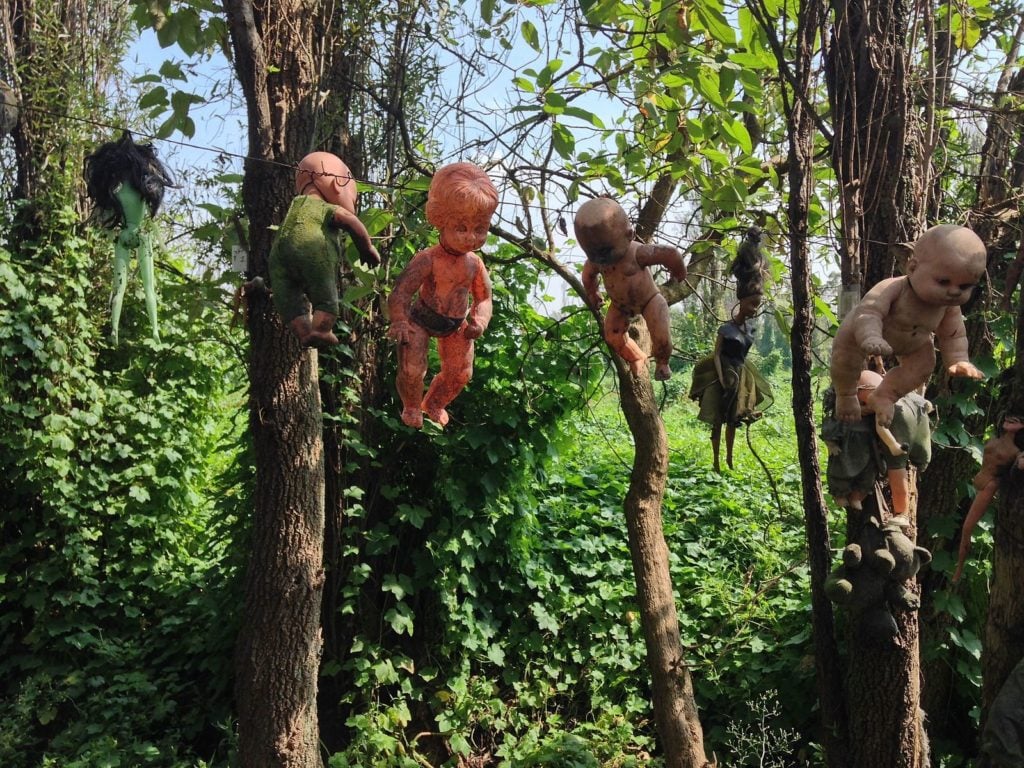
Whole dolls. Partial dolls. Doll heads, doll torsos, and doll limbs. Baby dolls and fashion dolls; clothed dolls and naked dolls; dolls covered in dirt and mud and vegetation and, occasionally, paint. Dolls hung from trees. Dolls impaled on branches. Dolls pinned to objects larger and more solid than themselves.
There are dolls everywhere, decaying in the sun and the rain and the elements.
But — according to some — they don’t always stay where they are. Sometimes, people say, they move.
[Like what you read? Check out Dangerous Games To Play In The Dark, available from Chronicle Books now!]
Located in the Xochimilco region of Mexico, the Island of the Dolls has only gained the reputation it currently has over the past several decades — a drop in the bucket over its long, long life. Technically it isn’t even an island; or, at least, it’s not a natural one. It’s a chinampa, a human-made landmass constructed by filling in a rectangular enclosure in a lakebed or other body of water with mud and plant matter. Built by the Aztecs for agricultural purposes, chinampas are often known as “floating gardens,” despite the fact that they don’t actually float. They do, however, provide fertile land for the growing of crops — and they also create a network of canals when they’re built in large numbers. Hence, Xochimilco’s characteristic canal system.
But few — if any — of Xochimilco’s chinampas are as notorious as the Island of the Dolls. And it’s all due to one man.
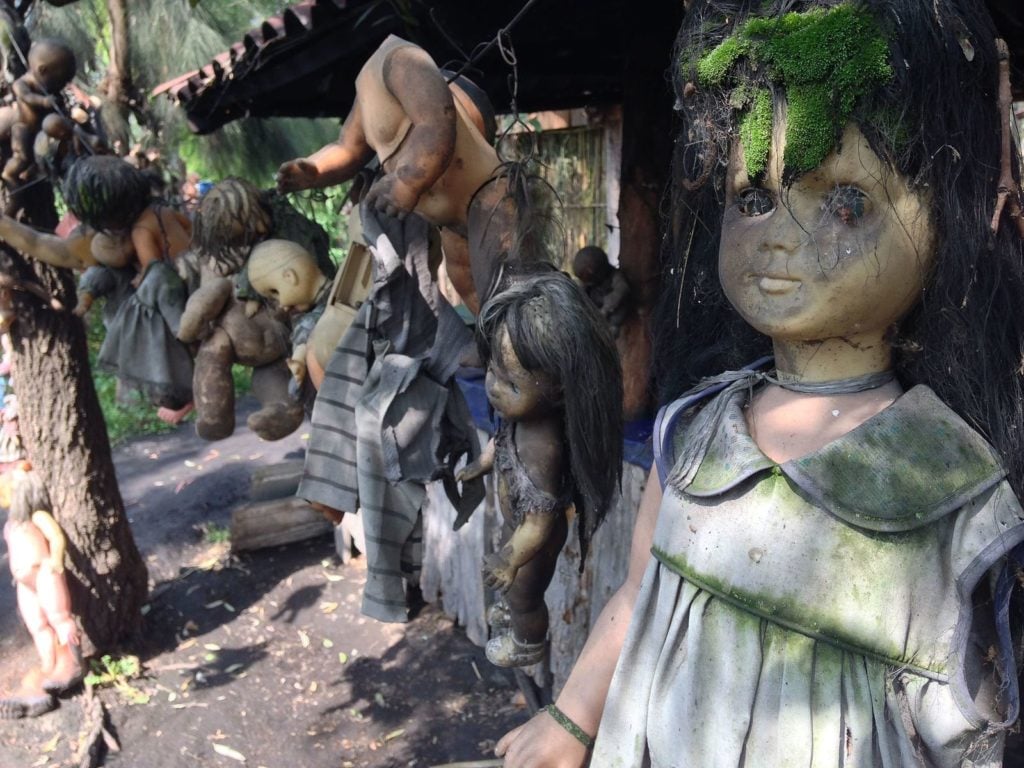
When it comes to the history of the Island of the Dolls, the line between fact and fiction is rapidly becoming indistinguishable; at this point, it’s not clear what might have actually happened and what might be pure myth. What we do know is this: In the 1950s, Don Julian Santana Barrera arrived on the island. He was married with children; however, he had left his family to go into exile, taking up residence on what was then just one of the many chinampas that are still in existence in Xochimilco. (It’s quite common for people to live on and farm chinampas, although the legality of these settlements isn’t always cut-and-dry.) Once he arrived, though, he began to do something curious: He started hanging up as many dolls as he could find, lashing them to tree branches with wire, nailing them into place on tree trunks and the walls of the cabin in which he lived, and impaling them on sticks and stakes. He got the dolls from various sources; he fished many out of the water, but he also retrieved them from trash heaps and occasionally traded with others for them using produce he grew on the island as a bartering chip. And he didn’t stop his activities for as long he lived: He died in 2001, still living on the island and still surrounded by his dolls. These days, the Island of the Dolls is a popular tourist attraction maintained by a relative of Don Julian, Anastasio Santana Velasco.
Here is what we don’t really — or, perhaps more accurately, what we don’t necessarily — know:
We don’t know why Don Julian moved to the island in the first place. According to some sources, he had been driven out of society due to his preaching of Christian theology at a time when the religion wasn’t well received; however, others gloss over the “why,” merely stating that he moved to the island without giving a reason for his relocation. Some also state outright that it’s not known why he chose to exile himself to the chinampa.
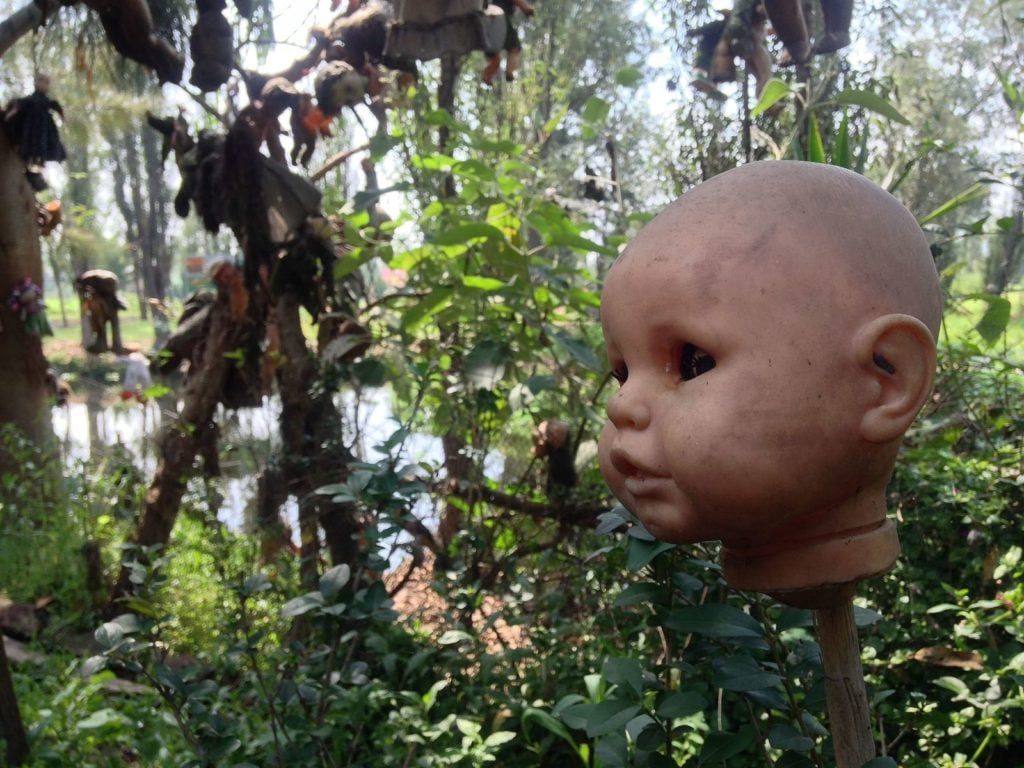
We don’t know why Don Julian began collecting the dolls or decorating the island with them. I mean, yes, we know that it has to do with an alleged death that occurred on the island, and with the alleged ghosts that haunt it — but we don’t know the truth of the story or the situation. Indeed, there are many stories, and they all conflict in at least some respect.
According to one account, the story begins in the early decades of the 20th century — the 1920s or the 1930s, depending on who you ask. In this version of the tale, a young girl drowned, perhaps while trying to retrieve a doll she had lost in the water; it is her spirit that is said to haunt the island, and her spirit that is said to have inspired Don Julian to begin hanging the dolls.
In another story, however, Don Julian allegedly witnessed a girl drown shortly after he moved to the island and was unable to save her. In this version, it’s said that his guilt over his inability to rescue the drowning victim is what prompted him to turn the island into a shrine filled with dolls — beginning with a doll that had belonged to the girl herself. In yet another version, Don Julian didn’t witness the alleged drowning first-hand, but found the girl’s body after the fact. Similarly, though, his guilt over not having be able to do anything to save the girl’s life led to the transformation of the chinampa into the Island of the Dolls.
For what it’s worth, Don Julian’s relative, Anastasio Santana Velasco — who is Don Julian’s nephew, although he’s sometimes erroneously cited as his cousin — told Bizarre Magazine in 2009:
“There are many stories about why the dolls are here. Some people claim Don Julian was mad, and that he’d fish dolls out of the canal believing they were real children, and that he could nurse them back to life. But the real story is that, soon after Don Julian arrived on the island, he came to believe this place was haunted by the spirit of a poor young girl who drowned in the canal. So, when he saw a doll floating past he took it and put it on a tree, both to protect himself from evil and make the dead girl happy. But one doll wasn’t enough; soon Don Julian had made the entire island into a shrine.”
Velasco further elaborated to Rachel Levin of Al Jazeera English in 2014, saying, “He found the dolls in the canals and in the trash. He started hanging them up to protect him, and to try to scare away the spirit of the girl.”
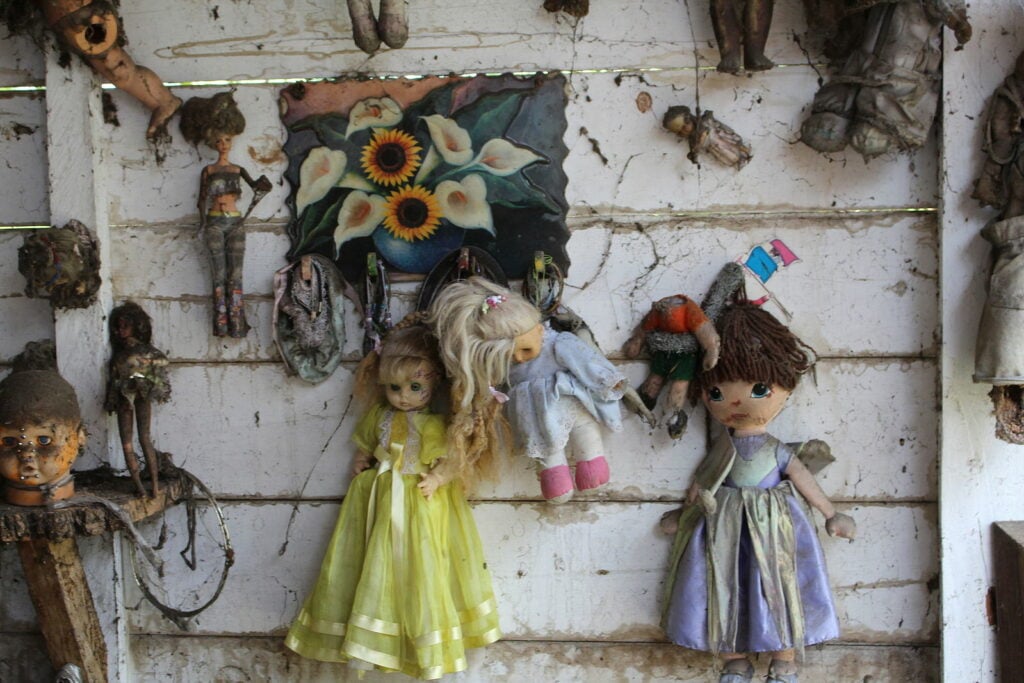
We don’t even really know who or what haunts the island — if anything actually haunts it at all. Most versions of the origin story suggest that the ghost of the alleged drowned girl possesses the dolls; trouble is, though, that no matter when this alleged drowning is meant to have occurred, there’s no evidence that it actually happened. According to some sources, some people — including his remaining family members — believe that Don Julian may have imagined the alleged girl and her watery death. Meanwhile, other versions of the story state that each of the dolls on the island are possessed by a different child’s spirit — and in yet other accounts, entities have allegedly been captured in photographs taken at the Island of the Dolls that look to be something else entirely. They’re not the spirits of children — and whatever they are, they’re allegedly malevolent in nature.
Sometimes, the dolls laugh. Or at least, that’s what some people say.
Don Julian’s death, too, is shrouded in mystery. He might have drowned; that’s what’s most commonly reported as the cause of his demise. However, some sources state that he suffered heart failure. Regardless, though, it’s usually said that he was found face-down in the water — a detail which is marked as relevant either because he’s where he allegedly witnessed that girl drown all those years ago, or because it’s the spot where he found the first doll he ever hung.
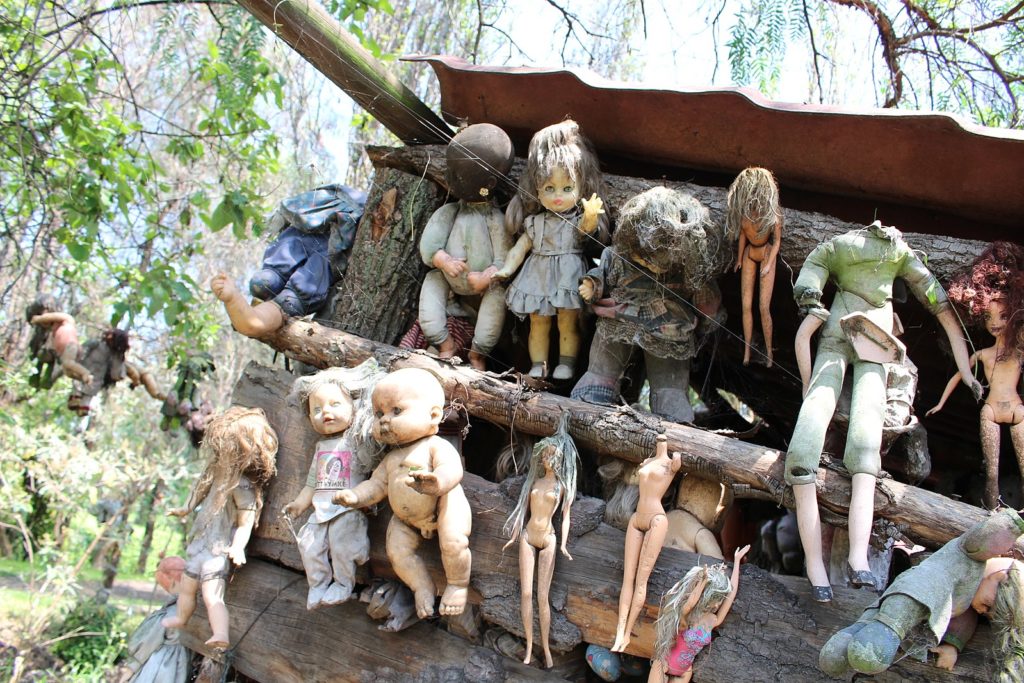
It’s unlikely that we’ll ever be able to unravel the “true” story behind the Island of the Dolls; even if Don Julian were still alive, something tells me that getting to the bottom of the whole thing would be difficult. Whatever his motivations might have been, though, we know what they yielded: An island, at once eerie and frightening and beautiful and serene, which is like nowhere else on Earth. And although Don Julian is no longer able to carry on his work, others have taken up his mantle; visitors from all over the world bring their own dolls with them and add them to the collection.
Will you add yours?
Recommended resources:
The Mysterious And Creepy Island Of Dolls.
Island Of The Dolls on Atlas Obscura.
Isla de las Munecas on Sluggo’s House O’ Spooks.
Island Of The Dolls: A Trip Down Mexico City’s Aztec Canals.
The Island Of The Dolls on Vice.
Mysterious Island Draws Tourists To Mexico.
Haunted Places episode 6: “Island Of The Dolls.”
***
Follow The Ghost In My Machine on Twitter @GhostMachine13 and on Facebook @TheGhostInMyMachine. And don’t forget to check out Dangerous Games To Play In The Dark, available now from Chronicle Books!
[Photos via Wikimedia Commons (1, 2, 3, 4, 5), available under a Creative Commons Attribution-Share Alike 4.0 International license.]